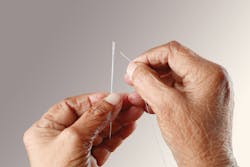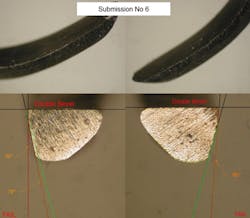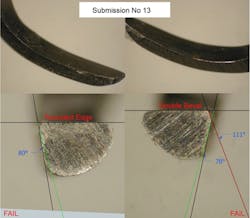Your best efforts! Author's informal survey indicates that dental hygienists do not retain sharpening skills
Author's informal survey indicates that dental hygienists do not retain sharpening skills
BY Lory Laughter, RDH, BS
Over 20 years have passed since my time in college, and one sound still sends chills down my spine. No, not nails on the chalkboard, but the sound of 19 fellow students grinding metal instruments against sharpening stones at the same time. Everyone chose the time just before patients arrived to accomplish the sharpening task, and from outside the building I'm sure it sounded a bit like torture. Aside from the obnoxious noise, one thing stood true - we were exacting with our angles and we were proficient at achieving a biting sharp edge.
As the years passed into clinical practice, the noise became less frequent. Time constraints, and the knowledge that once an instrument edge meets a stone, it's never the same, had a noticeable impact on our desire to sharpen instruments. Sharing instruments with other dental hygienists brought the reality that none of us sharpen exactly the same. Instrument life expectancy decreased, and a good working edge became a rare find.
------------------------------------------------------
Related articles
- Out of the mouths of babes: Instrumentation study with students offers a different perspective on sharpening
- No right or wrong answers
- Staying sharp is cutting edge
------------------------------------------------------
I initially solved the damaged instrument dilemma by not sharing instruments. I've worked with an amazing dentist the last 15 years who believes in quality materials and instruments. Yet the reality persisted - a sharpened edge equals declining function and hand fatigue. I decided it was worth finding out if dental hygienists are proficient at sharpening after graduation, or if it's a skill we lose over time.
To answer my question, I designed and conducted a small study of practicing hygienists who graduated five to 35 years ago. A survey was used to recruit hygienists who practice at least two days a week, and who rate themselves good or very good at sharpening. My goal was to see how many could maintain the factory edge angle after sharpening.
I mailed unmarked stainless steel Gracey 11/12 instruments to 46 participants, and included the following instructions:
1. Sterilize and use the Gracey as you would normally.
2. Use it until you feel it is dull and needs sharpening to be effective.
3. Sharpen until you feel the appropriate working, sharp edge is returned. Do not use after sharpening.
4. Sterilize and return to me in a sterilization bag. Please include your email address.
5. On the outside of the bag, write your sharpening method, i.e., Arkansas stone, ceramic stone, etc. Also, indicate whether or not you used a guide or automated system.
6. You do not need to do anything special with this instrument. Treat it as you would every other Gracey in your setup.
Participants were not told what was being studied. Information gathered from a survey conducted after the instruments were returned showed that most assumed they were evaluating the metal. I did not give any indication or insight on what I was looking for, nor did I give any instructions other than the ones above.
Twenty-five of the instruments were returned to me, two of which were discarded for breakage or failure to follow instructions. I included two control instruments that were sterilized and bagged to look like the study instruments. The control instruments were not used or sharpened. I thought 20% of dental hygienists would be able to maintain the factory edge angle after one sharpening. I was wrong - very wrong.
The instruments were examined for bevel angle relative to the industry standard (70° to 80°), consistency within the lateral surface, and coarseness of the beveled edge. After the instrument points were evaluated for the listed features and photographed, the tips were ground off approximately halfway into the full length of the cutting edge in order to be viewed under cross section. The final bevel angle could be measured more accurately this way.
The 23 instruments returned equaled 46 surfaces to be sharpened. Of those 46 surfaces, three were able to maintain factory angle. The percentage of those who were able to sharpen and maintain the angle was 6.5%. No participant maintained the angle on both sides of the instrument.
The purpose of the study was not to discount or discredit the education we receive for sharpening instruments. It is a skill we need to learn and master during our formal education. What the research shows is the skill is not maintained throughout our careers.
Recommendations could include periodic competency training in sharpening skills. Perhaps a CE course every five years would benefit the majority of practitioners. Another option could be to purchase instruments that do not require sharpening during the life of the instrument. American Eagle, Inc. XP technology instruments do not require sharpening. In my experience, these instruments are functional as long as standard stainless steel instruments, yet no sharpening is required. A sharp edge is maintained throughout the life of the instrument.
Whichever recommendation you choose, it is obvious clinicians are not proficient in sharpening skills five years and longer after graduation. When a problem is noted, proven steps must be taken to correct the deficiency. RDH
Lory Laughter, RDH, BS, practices clinically in Napa, Calif. She is owner of Dental IQ, a business responsible for the Annual Napa Dental Experience. Lory combines her love for travel with speaking nationally on a variety of topics. She can be contacted at [email protected].


